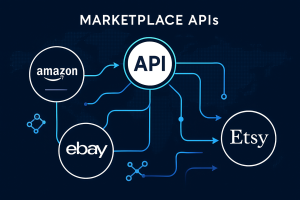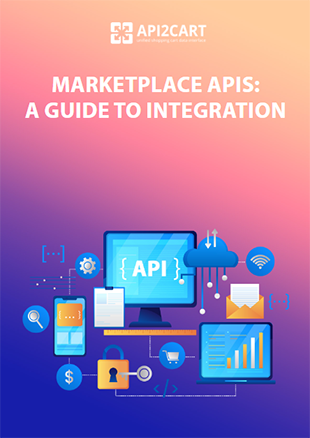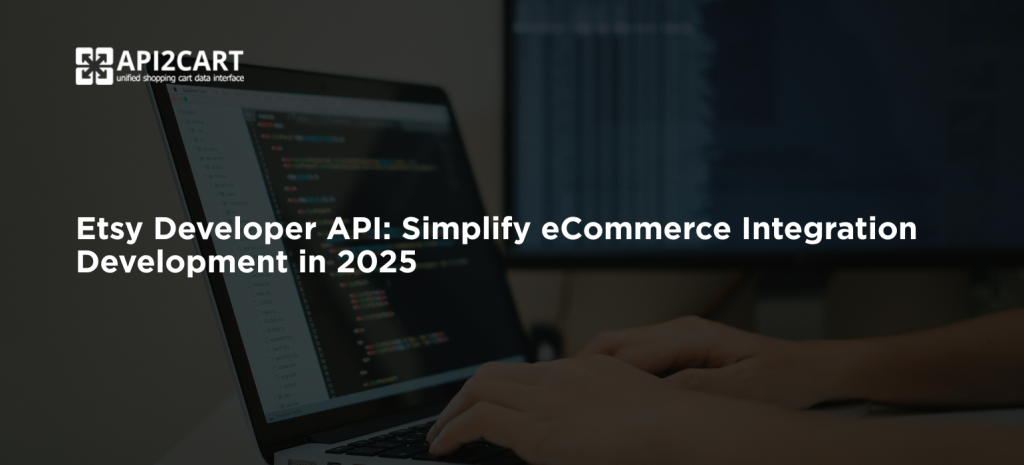
Today, developing an integration between your eCommerce software solution and marketplaces is not just a recomendation - it is a must. Marketplace APIs play a crucial role in this process as they enable your system to access and manage needed store data.
Mastering marketplace APIs is your key to expanding market reach, improving data accuracy, and delivering a better user experience. Marketplace APIs are transforming the way eCommerce businesses operate, enabling seamless integration and automation across various platforms. Basically, these APIs provide developers with the tools to connect multiple marketplaces, including Amazon, eBay, and Etsy. They simplify processes, such as order management, product listings, and customer data synchronization.
In this article, we will explore the benefits and functionalities of marketplace APIs. We'll look at the role they play in scaling eCommerce operations. Additionally, we will discuss how businesses can leverage them to enhance their efficiency and reach. Additionally, this article delves into a few well-known marketplace APIs that you should integrate with to stay ahead in the competitive eCommerce industry.
What are Marketplace APIs?
Marketplace APIs allow developers to access marketplace features and data, such as product catalogs, orders, and customer info. Also, these platform APIs help automate business logic, sync data, and reduce development time. Having a reliable marketplace API connection is key to scalability and fast integration.
Top 10 Best Marketplace APIs

Below, we'll take a closer look at some of the most popular marketplace APIs. Each one offers distinct features, opportunities, and challenges for developers looking to integrate their eCommerce solutions with them.
eBay Marketplace API
eBay powers close to 800,000 stores and serves millions monthly. Its API provides access to rich marketplace functions. However, it has quirks like mixed formats, so integration is better handled by experienced teams.
API2Cart offers key API methods for BigCommerce eBay integration, such as product.list, product.add, product.update, and product.delete, allowing seamless management of product listings across both platforms. Thus, API2Cart's unified API simplifies product management, inventory synchronization, and order fulfillment between BigCommerce and eBay, reducing development time and enhancing operational efficiency
Amazon API
Amazon's marketplace has over 9.1 million active sellers, and integrating with Amazon's API gives you access to a massive market, allowing you to tap into new opportunities and increase your software's customer base. Amazon marketplace API supports seller info, reviews, listings, and order updates. It is powerful but requires caution due to outdated elements. Particularly, it's a key API for developers working with marketplace platforms.
Walmart API
Walmart API integration provides software vendors access to key functions, including managing products, orders, inventory, and customer data, helping businesses to streamline their multi-channel eCommerce operations. Additionally, API2Cart enables seamless updates for pricing, product listings, and order synchronization across platforms, saving significant development time and operational costs while ensuring smooth and continuous data flow.
This REST-based API is well-documented and allows easy access to orders, inventory, and products. It is one of the simplest API connections among major marketplaces.
Etsy API
Built for user-friendliness, Etsy API uses OAuth and JSON. It's ideal for light integration with handmade goods stores. Compared to other marketplace API tools, it is easier to work with. Etsy API enables you to easily access important e-store data, including shop information, product listings, customer details, and orders, giving developers full control over store operations. With more than 7.3 million sellers and 39 million buyers in 2022, Etsy has grown into a major marketplace, offering immense potential for eCommerce businesses to expand their reach
MercadoLibre API
This Latin American marketplace offers secure REST APIs. Also, it includes endpoints for products, tax, shipping, and more. It's ideal for apps targeting fast-growing regional markets. The API's RESTful architecture, familiar to most developers, simplifies integration by using standard HTTP methods such as GET, POST, PUT, and DELETE for efficient data handling. So, using API2Cart to integrate with MercadoLibre removes the complexity of managing separate API connections, allowing developers to streamline their efforts while providing a unified interface for managing product catalogs, orders, and customer data across multiple platforms.
Aliexpress API
Designed for automation, this API enables order handling, product updates, and integration with third-party platforms. A strong option in Asia's marketplace API landscape.
Flipkart Marketplace API
Uses OAuth and Sandbox. With GET, PUT, and DELETE, developers can access order, product, and stock data easily. Great for multi-channel integrations.
Shopee API
Offers detailed documentation and fast testing tools. Shopee API helps developers expand into the Southeast Asia market. A standout among regional marketplace APIs.
Taobao API
Taobao has upgraded to RESTful endpoints, enabling access to shops, orders, products, and shipping data. Strong platform for China-based eCommerce expansion.
Lazada API
With 135k merchants, Lazada provides high-performance APIs for marketing, orders, and payments. One of the most complete marketplace API ecosystems.

Wait!
📘 Want to explore how to integrate your software with Amazon, Etsy, eBay, and other marketplaces?
Download the free guide and learn the key aspects of working with marketplace APIs and building integrations efficiently.
How to Easily Develop Integration with Marketplace APIs
To expand globally, you must connect your app or software to several marketplace APIs. But you don't need to build each marketplace integration manually.
API2Cart lets you connect with 60+ shopping platforms and marketplace APIs, including Amazon, eBay, Walmart, Etsy, and more. You can manage product, order, and shipping data via a single API.
Generally, using API2Cart API methods you can get, update, and delete store info from any marketplace or eCommerce platorms. It's fast, secure, and made for scale.

Also, API2Cart allows you to add products to Amazon using the convenient product.add method, simplifying the integration process and saving developers time and resources — you can find a detailed example of the request in our documentation.
{
'return_code': 0,
'return_message': 'string',
'result': {
'id': 'string',
'type': 'string',
'u_model': 'string',
'u_sku': 'string',
'name': 'string',
'description': 'string',
'short_description': 'string',
'price': 0,
'advanced_price': [
{
'id': 'string',
'value': 0,
'avail': true,
'group_id': 'string',
'quantity_from': 0,
'start_time': {
'value': 'string',
'format': 'string',
'additional_fields': {},
'custom_fields': {}
},
'expire_time': {
'value': 'string',
'format': 'string',
'additional_fields': {},
'custom_fields': {}
},
'additional_fields': {},
'custom_fields': {}
}
],
'cost_price': 0,
'quantity': 0,
'inventory': [
{
'warehouse_id': 'string',
'quantity': 0,
'in_stock': true,
'priority': 0,
'additional_fields': {},
'custom_fields': {}
}
],
'group_items': [
{
'child_item_id': 'string',
'product_id': 'string',
'default_qty_in_pack': 'string',
'is_qty_in_pack_fixed': true,
'price': 0,
'additional_fields': {},
'custom_fields': {}
}
],
'u_brand_id': 'string',
'u_brand': 'string',
'categories_ids': [
'string'
],
'stores_ids': [
'string'
],
'url': 'string',
'seo_url': 'string',
'meta_title': 'string',
'meta_keywords': 'string',
'meta_description': 'string',
'avail_sale': true,
'avail_view': true,
'is_virtual': true,
'is_downloadable': true,
'weight': 0,
'weight_unit': 'string',
'sort_order': 0,
'in_stock': true,
'on_sale': true,
'backorders': 'string',
'manage_stock': 'string',
'is_stock_managed': true,
'create_at': {
'value': 'string',
'format': 'string',
'additional_fields': {},
'custom_fields': {}
},
'modified_at': {
'value': 'string',
'format': 'string',
'additional_fields': {},
'custom_fields': {}
},
'tax_class_id': 'string',
'special_price': {
'value': 0,
'avail': true,
'created_at': {
'value': 'string',
'format': 'string',
'additional_fields': {},
'custom_fields': {}
},
'modified_at': {
'value': 'string',
'format': 'string',
'additional_fields': {},
'custom_fields': {}
},
'expired_at': {
'value': 'string',
'format': 'string',
'additional_fields': {},
'custom_fields': {}
},
'additional_fields': {},
'custom_fields': {}
},
'tier_price': [
{
'qty': 0,
'price': 0,
'additional_fields': {},
'custom_fields': {}
}
],
'group_price': [
{
'id': 'string',
'group_id': 'string',
'price': 0,
'store_id': 'string',
'quantity': 0,
'start_time': 'string',
'expire_time': 'string',
'additional_fields': {},
'custom_fields': {}
}
],
'images': [
{
'id': 'string',
'http_path': 'string',
'file_name': 'string',
'mime-type': 'string',
'size': 0,
'create_at': {
'value': 'string',
'format': 'string',
'additional_fields': {},
'custom_fields': {}
},
'modified_at': {
'value': 'string',
'format': 'string',
'additional_fields': {},
'custom_fields': {}
},
'alt': 'string',
'avail': true,
'sort_order': 0,
'type': 'string',
'additional_fields': {},
'custom_fields': {}
}
],
'product_options': [
{
'id': 'string',
'product_option_id': 'string',
'name': 'string',
'description': 'string',
'sort_order': 0,
'type': 'string',
'required': true,
'available': true,
'used_in_combination': true,
'option_items': [
{
'id': 'string',
'product_option_item_id': 'string',
'name': 'string',
'sort_order': 0,
'price': 'string',
'weight': 'string',
'quantity': 0,
'type_price': 'string',
'sku': 'string',
'is_default': true,
'additional_fields': {},
'custom_fields': {}
}
],
'additional_fields': {},
'custom_fields': {}
}
],
'u_upc': 'string',
'u_mpn': 'string',
'u_gtin': 'string',
'u_isbn': 'string',
'u_ean': 'string',
'related_products_ids': [
'string'
],
'up_sell_products_ids': [
'string'
],
'cross_sell_products_ids': [
'string'
],
'dimensions_unit': 'string',
'width': 0,
'height': 0,
'length': 0,
'discounts': [
{
'id': 'string',
'name': 'string',
'modifier_type': 'string',
'value': 0,
'from_time': 'string',
'to_time': 'string',
'customer_group_ids': 'string',
'sort_order': 0,
'additional_fields': {},
'custom_fields': {}
}
],
'additional_fields': {},
'custom_fields': {}
}
}
So, want to test API2Cart for free? Book a call with our manager who will guide you through the registration process and discuss how API2Cart can meet your business needs.
Fill out the form below to get the guide:

Marketplace API Guide to Integration
Discover the detailed info related to marketplace API integration.



